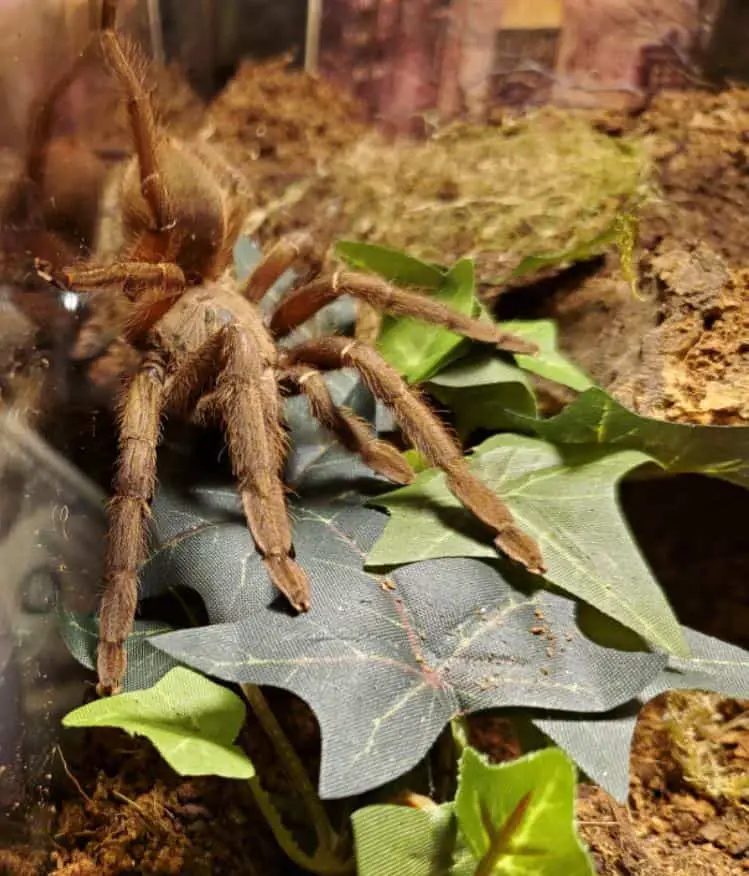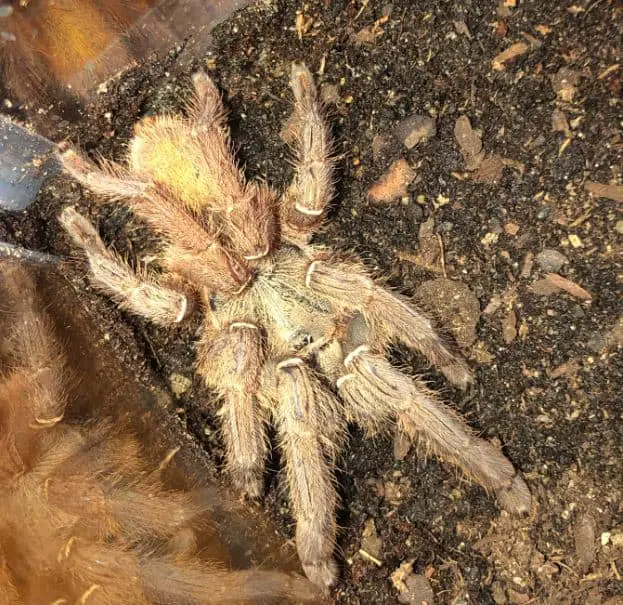The Emerald Skeleton Tarantula (Ephebopus uatuman) is a New World terrestrial species native to Brazil. They’re known for their green coloration on the abdomen and emerald sheen on the carapace, making them highly desired among collectors.
If this interesting-looking tarantula has caught your eye and you’re considering adding it to your collection, you’ve come to the right place.

Emerald Skeleton Tarantula Care Sheet
| Species Name | Ephebopus Uataman |
| Family Name | Theraphosidae |
| Common Names | Emerald Skeleton Tarantula |
| Category | New World |
| Type | Terrestrial burrower |
| Native Location | Brazil |
| Leg Span | 4 inches (~10 cm) |
| Growth Speed | Fast |
| Urticating Hairs | Yes |
| Social | Solitary |
| Diet | Insects: primarily crickets and roaches |
| Temperature | 70 to 80 degrees °F |
| Humidity | 70 to 75% |
| Lifespan | Female: 15 years / Male: 2 to 4 years |
| Experience required | Intermediate – advanced |
| Minimum tank size | 12″x8″x8″, horizontal space > vertical space |
Emerald Skeleton Tarantula Overview
Ephebopus Uataman, known in the hobby as the Emerald Skeleton Tarantula (EST) is a terrestrial species that’s endemic to Brazil where they live on the forest floors.
They’re obligate burrows, which means that they create their burrows underground. They spend quite a bit of time in their burrow, often only coming out when it’s time to eat.
To eat, they spin silk in front of their burrow. When prey is nearby, they can feel the vibrations in the silk and then they come out to ambush it. They also create impressive web tunnels.
Appearance & Variants

The Emerald Skeleton Tarantula is generally olive to khaki in color. Sometimes, they also have a distinctive green spot on their abdomen, which makes them very recognizable. They also typically have 1 set of white/yellowish bands on their legs.
An interesting thing to note is that the E. Uataman does not have the leg striping that the E. Murinus and E. Rufescens do have which is the reason why these species are called “skeleton tarantulas” by hobbyists in the first place.
As a result, many people are confused about why the E. Uataman is called the Emerald Skeleton Tarantula if they do not have the same leg striping. It could be to indicate the relation to the Ephebopus genus more clearly, but nobody knows for sure. On top of that, they’re typically more olive or khaki in color than emerald, making the whole name a bit weird.
These spiders are sexually dimorphic with males being smaller than females. However, even though females are bigger than males, they’re still not very large, topping out at a size of around 4 inches.
In addition, males typically have brighter colors, especially right after a molt. As time progresses after a molt, their colors tend to fade and they become more khaki to olive in color rather than emerald.
Price
The Emerald Skeleton Tarantula is not all that expensive. Slings can be found for around $35, while adults are typically between $100 and $200, depending on whether you buy a male or female.
Females are more expensive because they have a much longer lifespan.
Temperament & Behavior
The Emerald Skeleton Tarantula is quite a defensive species. Their first instinct is to run away from danger, but if that does not work, they’re quick to strike a threat posture. If that still does not deter their threat, they’re quite quick to bite.
They are venomous, but their venom is not very potent and is not threatening to a healthy adult.
In addition, they’re fossorial spiders, which means that they will create their burrows underground and spend a lot of time there. As a result, you might not see them out in the open as often as you’d like.
They’re definitely not suitable as show tarantulas and are sometimes described as a pet hole.
On the whole, they’re not great for beginners due to their defensive nature. Even for experts, it’s not recommended to handle them because they have a high chance of getting bitten.
Caring for an Emerald Skeleton Tarantula
Tank setup
Since the Emerald Skeleton Tarantula is a terrestrial burrowing species they need an enclosure that emphasizes horizontal over vertical space.
This species is not the largest tarantula, so their enclosure does not need to be all that big. At a minimum make sure that they have a terrarium that’s 12″x8″x8″.
They do not necessarily need a hide, since they will create their own burrow in the substrate. However, you can give them some extra places to hide by providing them with a piece of cork bark.
Other decorations that you can place in their enclosure include rocks and artificial plants.
Substrate
As an obligate borrower, substrate is important for the Emerald Skeleton Tarantula.
Adults need a layer of substrate that’s at least 6 inches deep to give them enough space to create their burrows.
Materials to use for the substrate include peat moss, vermiculite, and coconut fiber. Mixing all of these together will create a great substrate for them to create their burrow in.
If you’d like to see your spider will it’s inside its burrow, try digging a small hole at the side of the enclosure, near the glass. They will often use this starting hole as the base of their burrow. If they do, you’ll be able to see your tarantula through the glass.
Temperature & Humidity
Temperatures of 70 to 80 degrees Fahrenheit and humidity between 70 and 75% are ideal for your Emerald Skeleton Tarantula to grow and thrive. Ventilation is also important to avoid the growth of bacteria.
Watering
Wet the substrate every other month to keep it relatively damp.
To drink, adult Emerald Skeleton Tarantulas need a water bowl, while slings will drink droplets that you can drip down the side of the enclosure.
Social
Some tarantula species are capable of communal living, but not the Emerald Skeleton Tarantula. They must be housed solitarily because placing more than one of these spiders in a single enclosure is very likely to result in cannibalism due to the species’ territorial nature.
Diet & Feeding
The Emerald Skeleton Tarantula might be small in size, but they’re good eaters.
The best food for slings is flightless fruitflies or cricket legs.
As they grow into juveniles, you can start feeding them baby crickets.
Adults should eat primarily dubia roaches and large crickets. Generally speaking, you should feed them one roach or two crickets a week, but this depends on the size of your specimen. You can also feed them mealworms occasionally.
When feeding, it’s important that you only feed them captive-bred insects to avoid parasites.
Also, after your tarantula has molted, they should not be fed for a few days because they’re incapable of eating until their fangs have hardened.
Health & Lifespan
On average, you can expect female Emerald Skeleton Tarantulas to live for up to 15 years, while males will live much shorter at only 2 to 4 years.
They are quite a hardy species that is easy to keep in good health. As long as you keep their enclosure clean, remove uneaten food, replenish their water frequently, and are careful that they do not fall, there’s not much preventing them from reaching their maximum lifespan.
Facts about the Emerald Skeleton Tarantula Facts
- This spider is incredibly fast for a New World species.
- They don’t go very deep into their burrow and tend to stay near the mouth of their burrow waiting for prey.
- It’s not recommended to handle this tarantula. Their defensive nature does not make them very suitable for it.
- In contrast to many other New World species, the urticating hairs of the E. Uataman are located on the pedipalps rather than the abdomen.
- This species was first discovered in 1992.
Final words
The Emerald Skeleton Tarantula is not the best pick for beginners. Despite their beautiful and unique colors, they do not spend a whole lot of time out in the open. On top of that, they’re not very docile and have a tendency to show defensive behavior. Beginners are better off starting out with a more docile species such as the Arizona Blonde or the Antilles PinkToe Tarantula.
However, if you’re experienced with handling species like this then the Emerald Skeleton Tarantula might be a welcome addition to your collection. They might not be the best show spiders, but they have a great feeding response and when you do get to see them, they’re quite interesting to behold.
- How Long Do American Eskimo Dogs Live? Important Factors and Care Tips - September 29, 2023
- Do American Bulldogs Need Grooming? Essential Tips and Care Guidelines - September 29, 2023
- Do Bengal Cats Enjoy Playing? Essential Tips for Keeping Them Active - September 29, 2023